ISSN 2348-1196 (print)
International Journal of Computer Science and Information Technology Research ISSN 2348-120X (online) Vol. 9, Issue 4, pp: (65-74), Month: October - December 2021, Available at: www.researchpublish.com

ISSN 2348-1196 (print)
International Journal of Computer Science and Information Technology Research ISSN 2348-120X (online) Vol. 9, Issue 4, pp: (65-74), Month: October - December 2021, Available at: www.researchpublish.com
1Ms. Suganya. R., 2Mrs. Geetha. S.
1 M.Phil Research Scholar, Department of Computer Science Muthurangam Government Arts College (Autonomous), Vellore, TamilNadu, India.
2 Assistant Prof, Department of Computer Science Muthurangam Government Arts College (Autonomous), Vellore, TamilNadu, India.
Abstract: Cardiovascular disease is a major cause of disability and premature death throughout the world, and contributes substantially to the escalating costs of health care. The underlying pathology is atherosclerosis, which develops over many years and is usually advanced by the time symptoms occur, generally in middle age. Acute coronary and cerebrovascular events frequently occur suddenly, and are often fatal before medical care can be given. Modification of risk factors has been shown to reduce mortality and morbidity in people with diagnosed or undiagnosed cardiovascular disease. Type 2 Heart Disease and coronary artery disease (CAD) are conditions that cause a substantial public health burden. Since both conditions often coexist in the same individual, it has been hypothesized that they have a common effector. Insulin and hyperglycemia are assumed to play critical roles in this scenario. In recent years, many genetic risk factors for both hearts and CAD have been discovered, mainly through genome-wide association studies. Genetic aspects of hearts, heart macrovascular complications, and CAD are assumed to have intersections leading to the common effector hypothesis. However, only a few genetic risk factors could be identified that modulate the risk for both conditions. Polymorphisms in TCF7L2 and near the CDKN2A/B genes seem to be of great importance in this regard since they appear to modulate both conditions, and they are not necessarily related to insularism, or hyperglycemia, for CAD development. Other issues related to this hypothesis, such as the problems of phenotype heterogeneity, are also of interest. Recent studies have contributed to a better understanding of the complex genetics of heart macrovascular complications. Much effort is still needed to clarify the associations in the genetics of hearts, and cardiovascular disease. At present, there is little genetic evidence to support a common effector hypothesis, other than insulin or hyperglycemia, for the association between these conditions.
Keywords: Heart Disease and coronary artery disease, phenotype heterogeneity, Prediction of CAD.
Cardiovascular disease (CVD) covers a broad group of disorders, including diseases of the cardiac muscle and of the vascular system supplying blood to the heart, brain, and other vital organs. Predominant CVDs are Ischemic heart disease (IHD) otherwise called Coronary Artery Disease (CAD), Stroke and Congestive Heart Failure (CHF). Rheumatic Heart Disease (RHD), Congenital Heart abnormalities and Cardiomyopathy are the other classes of disease included in CVD. Among them CAD is the most common clinical manifestation, and the single largest cause of death in both developed and developing countries (Gaziano et al., 2006; Kovacic and Fuster, 2011). Approximately 80% of CVD mediated mortality was reported from low and middle-income countries like India. Various studies reported that CVD has reached epidemic proportions in many developing countries including India and CVD mediated mortality rate is high in South India (Gupta et al., 2012; Gupta et al., 2013; Siegel et al., 2014).
As per the Disease Control Priorities in Developing Countries (DCPP) report, CAD mortality rates in India between 2000 and 2030, predicted be about 35 percent and which would occur among age group of 35 to 64. Also in 2016 Asian Indians would account for 40-60% of global CAD burden (Gaziano et al., 2006). Asian Indians develop clinical manifestations
ISSN 2348-1196 (print)
International Journal of Computer Science and Information Technology Research ISSN 2348-120X (online)
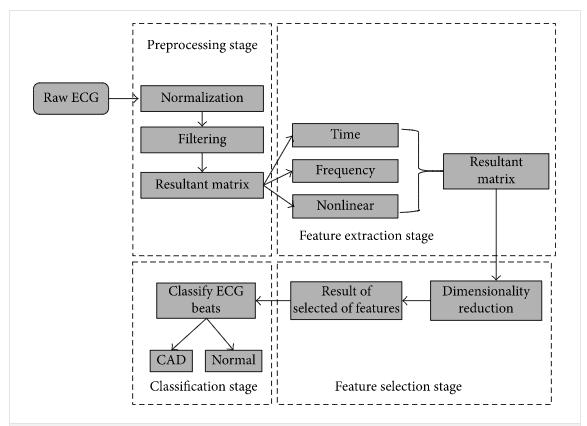
Vol. 9, Issue 4, pp: (65-74), Month: October - December 2021, Available at: www.researchpublish.com
such as myocardial infarction (MI) at a young age and approximately 50% of the first MI among Indian men occurs before the age of 55 years and 25% occurs before 40 years (Enas et al., 2013). Statistics from Tamil Nadu Health Systems Project (TNHSP) reported that the crude mortality rate due to CVD in Tamil Nadu is about 360-430 per 100,000 populations, and remains the highest in the country. Around 10.4% of population in Tamil Nadu suffer from diabetes, 20% from high blood pressure and 23% were overweight (TNHSP, 2012) moreover the scenario is similar in all the Indian population.
INTERHEART and INTERSTROKE studies established that 9 key risk factors [smoking, lipids, hypertension, diabetes, obesity, High-fat diet, physical inactivity, alcohol consumption and mental stress] could attribute >86% of CVD risk (Siegel et al., 2014). CAD is considered to be a polygenic disease involving more than 400 genes and an ever increasing number of genetic risk factors continue to be identified acting individually and in combination to contribute to the pathogenesis of CAD (Dzau and Liew, 2007). Genome Wide Association Studies (GWAS) screened thousands of CAD patients and identified a number of genetic variants at chromosomal loci (9p21.3, 1p13) and other candidate SNPs specific to CAD/MI in various populations (Scheffold et al., 2011). The SNPs identified consistently in various GWAS have clinical and public health importance, particularly for developing preventive or therapeutic interventions for CAD. Analyzing the SNPs most significantly associated with CAD in south Indian population will be useful to identify the promising SNP-CAD association unique to the study population. Screening the SNP risk variants for complex traits like CAD, diabetes, Cancer and other Psychiatric disorders was recommended as a part of routine clinical assessment (O'Donnell and Nabel, 2011; Roberts and Stewart, 2012a). The threat posed by CAD highlights the importance of studying the genetic factors associated with the risk of CAD and premature MI and may lead to the development of novel genetic diagnostic assays specific for the Indian population.
Treatment management for CAD patients were followed in two regimens, the primary treatment regime were achieved by targeting hypertension, using anti- hypertensive drugs (diuretics, vasodilators, Angiotensin Converting Enzyme [ACE] inhibitors, Ca2+ channel blockers and β-adrenergic antagonists) and plasma lipoproteins using anti-hyperlipidemic drugs to reduce the total cholesterol and LDL-C levels in blood (statins, fibrates). The secondary preventive regime for Acute Coronary Syndrome (ACS) patients require additional treatment with anti-platelet agents (aspirin, clopidogrel) along with the primary drugs to prevent stent induced thrombosis (Parker and Brunton, 2008). Among these drugs statin and clopidogrel are widely prescribed to the CAD patients, statin is prescribed as primary care drug to prevent CAD and clopidogrel is given as lifesaving drug for ACS patients.
The statin reduces the LDL levels by inhibiting HMG-CoA reductase and clopidogrel prevents the platelet aggregation by irreversible inhibition of P2Y12 receptor on platelets and these two drugs show wide inter-individual variability in treatment response among patient. Genetic variations in the drug transporters (SLCO1B1) and drug metabolizers (CYP2C19) were reported to account for these treatment response variations
ISSN 2348-1196 (print)
International Journal of Computer Science and Information Technology Research ISSN 2348-120X (online) Vol. 9, Issue 4, pp: (65-74), Month: October - December 2021, Available at: www.researchpublish.com
The initial two steps of Figure 1 are preprocessing and feature extraction. These stages are widely used in the literature [7–10] which used signal recording (noninvasive data) to identify CAD symptoms. The techniques utilized in first two stages directly influence the classification results; therefore, it is necessary to choose the technique carefully. Subsequently, the remaining two stages of workflows (feature reduction and classification) are the same for both studies in Figures 1 and 2. Note that workflows for evaluation process of future works are a significant contribution to this review work. In the recent studies, we find a review of signal recording pattern recognition and classification [11] techniques based on nonlinear transformation. Raj Kumar et al. [12] performed an extensive review and comparative analysis of methods used for CAD classification. In specific, they [12] did not focus on the workflows for the evaluation process of future direction and their study only reviews the state-of-the-art classifiers. However, our study focuses on more up-todate literature review. Furthermore, our study performs a special review of existing classification methods.
In this study, a total of 92 individuals, 52 coronary artery patients (47 males and 5 females) aged between 32 and 54 years (mean age ± SD: 47.6 ± 5.8 years) and 39 healthy controls (24 females and 15 males) aged between 19 and 60 years (mean age ± SD: 44.8 ± 9.8 years) were examined. The CAD patients were treated and followed up in the Cardiology Department of Ondokuz Mayis University Research Hospital, Samsun, Turkey. All the unrelated participants (patients and controls) were from Northern Turkey. The clinical data of patients including hypertension, diabetes, hypercholesterolemia, family history of CAD, smoking habits and number of diseased vessels were recorded (Table 1). Coronary risk factors were defined according to following criterions: hypertension was defined if the patients' blood pressure was > 140/90 mmHg or if they were receiving any antihypertensive treatment; diabetes was defined if they were receiving any antidiabetic medication; hypercholesterolemia, was considered when their triglyceride concentration was > 200 mg/dL, their total cholesterol concentration was > 200 mg/dL, or they were receiving lipid-lowering drugs. Smoking habit was defined as never and current smoker. The family history of CAD was defined as positive if at least one firstdegree relative was diagnosed with CAD. Coronary angiography was applied to all patients. If the luminal diameter of at least one epicardial coronary artery was narrowed by > 50%, coronary stenosis was accepted significant. The exclusion critters for control group were hypertension, diabetes, hypercholesterolemia and family history of CAD and CVD. Diabetes was considered present if the participant was under treatment with insulin or oral hypoglycemic agents, if casual blood glucose determinations exceeded 150 mg/dL at two clinic visits in the original cohort, or if fasting blood glucose exceeded 140 mg/dL at the initial examination of the Offspring Study participants. Blood was drawn at the baseline examination after an overnight fast, and EDTA plasma was used for all cholesterol and triglyceride measurements. Cholesterol was determined according to the A bell-Kendall technique
Table1: Clinical characteristics of CAD patients
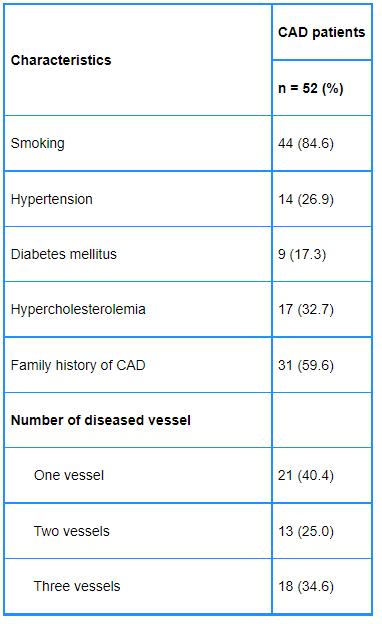
ISSN 2348-1196 (print)
International Journal of Computer Science and Information Technology Research ISSN 2348-120X (online)
Vol. 9, Issue 4, pp: (65-74), Month: October - December 2021, Available at: www.researchpublish.com
Statistical tests included age-adjusted linear regression or logistic regression to test for trends across blood pressure, TC, LDL-C, and HDL-C categories.18 Age-adjusted Cox proportional hazards regression and its accompanying c statistic were used to test for the relation between various independent variables and the CHD outcome and to evaluate the discriminatory ability of various prediction models.1920 The 12-year follow-up was used in the proportional hazards models, and results were adapted to provide 10-year CHD incidence estimates. Separate score sheets were developed for each sex using TC and LDL-C categories. These sheets adapted the results of proportional hazards regressions by use of a system that assigned points for each risk factor based on the value for the corresponding β-coefficient of the regression analyses.
The relative risk, but not the attributable risk, for TC and CHD declines with advancing age.21 Quadratic terms for age was considered in the models for the score sheets. Furthermore, CHD risk is associated with HDL-C in the elderly, 222324 and interaction terms for TC and age were also considered in the development of the prediction models.22 among women, an age-squared term was found to be significant in the prediction models and was incorporated into the score sheets. Neither age×TC nor age×LDL-C was found to be significant in either sex.
3.1.
The present study is a case-control genetic association analysis involving:
I. Clinical Cases: clinically diagnosed Coronary artery disease (CAD) patients with one or more blocks in coronary arteries, caused by atherosclerosis resulting in myocardial infarction or heart attack.
II. Controls: age and sex matched healthy adults; clinically evaluated with no risk of CAD and any systemic disease were selected as control subjects.
I.
Patients who were clinically diagnosed by Echo/ Electro Cardiogram and Percutaneous Coronary Intervention (PCI) with confirmed Acute Coronary Syndrome (ACS) of all ages and both sexes were recruited for the present study.
Patients with age <18 or >80 years, Pregnant women, Valvular heart disease, Cardiomyopathy, Patients on cardio-toxic medications, Pre-existing Chronic Obstructive Lung Disease, Chronic Kidney Disease, Chronic Liver Disease were excluded from the study.
3.3.
Present investigation is a Case-Control genetic study analyzing the GWAS annotated SNPs and its association with CAD of South Indian population and screening functionally well characterized pharmacogenetic SNPs (Statin and Clopidogrel) among South Indian CAD patients.
3.3.1. Study Centre
• Department of Genetics, Dr. ALM PG Institute of Basic Medical Sciences, University of Madras, Taramani, Chennai – 113.
• Department of Cardiology, Rajiv Gandhi Government General Hospital, Chennai – 3.
3.4
Patients who were diagnosed with history of MI and admitted in the intensive care unit of Dept. of Cardiology were explained about the study procedure and purpose and those who were willing to participate were enrolled. Those who met inclusion criteria were recruited and informed consent was obtained prior to any study related procedure.
Detailed medical history, clinical examination and baseline laboratory investigations were documented using a standard questionnaire (Appendix-II). The following clinical and biochemical data were collected from the patient’s data sheet
•
ISSN 2348-1196 (print)
International Journal of Computer Science and Information Technology Research ISSN 2348-120X (online) Vol. 9, Issue 4, pp: (65-74), Month: October - December 2021, Available at: www.researchpublish.com
• Heart rate & Systolic and Diastolic blood pressures
• Smoking & Alcoholic status
• Diabetic & Hypertensive conditions
• Blood sugar
• Serum – Total cholesterol (TC), Triglyceride (TGL), HDL, LDL
Fig2: Adapted from Taqman SNP genotyping assay guide by Applied Biosystems (ABI-USA)

Taqman probe-based chemistry uses a fluorescent probe to detect specific PCR product as it accumulates during PCR cycles (Lee et al., 1993). The allele specific probes were designed and each probe were labeled at 3’ end with different fluorescent dye (Allele-1– VIC labeled; Allele-2 – FAM labeled) and at 5’ end a non- fluorescent quencher, which quenches the fluorescence of the dye completely being close together in the probe. PCR amplification was done using Taq DNA polymerase enzyme using sequence specific primers. The 5’ exonuclease activity of Taq DNA polymerase hydrolyzes the fluorescent probes and results in emission of fluorescence by the dyes, which would be detected by laser in the real-time PCR (Fig 3.1). Based on the amount of fluorescence of VIC or FAM the genotype of the DNA sample can be identified: fluorescence of VIC only- homozygous allele-1, fluorescence of FAM only – homozygous allele-2 and fluorescence of both VIC and FAM – heterozygous allele-1&2.
1. CVDs due to atherosclerosis: ischaemic heart disease or coronary artery disease (e.g. heart attack) cerebrovascular disease (e.g. stroke)
diseases of the aorta and arteries, including hypertension and peripheral vascular disease.
2. Other CVDs congenital heart disease rheumatic heart disease cardiomyopathies cardiac arrhythmias.
ISSN 2348-1196 (print)
International Journal of Computer Science and Information Technology Research ISSN 2348-120X (online) Vol. 9, Issue 4, pp: (65-74), Month: October - December 2021, Available at: www.researchpublish.com
Deaths due to heart attacks, strokes and other types of CVDs as a proportion of total cardiovascular deaths for males and females are the global CVD mortality rates in males and females, respectively (1). Figures 8 and 9 show the global disease burden (DALYs) due to CVDs in males and females, respectively (2). The disability-adjusted life year (DALY) is a measure of overall disease burden, expressed as the number of years lost due to ill-health, disability or early death (premature death). CVDs and their risk factors are major contributors to global morbidity and mortality (1–5).
Data extracted from articles included information concerning the publication, the patients involved, and outcomes of interest. Publication items included the first author, year of publication, the country in which the data were collected, and date of data collection. Patient data collected included the number of patients screened, percentages of males and females, average age, duration of T2DM, the proportion with obesity (or average body mass index (BMI) ± SD). Outcome data consisted of the numbers and percentages of patients having each cardiovascular outcome, overall and separately for males and females, where available. The same procedure (two independent reviewers plus a third judge) was followed for data collection as for article selection.
Data were analyzed descriptively, with sums, averages, and medians, and ranges reported. The primary outcome was the estimate of prevalence rates of CVD in patients with T2DM. No overall quantitative synthesis was undertaken. Weighted averages were calculated for individual countries and IDF regions. For patient characteristics, we calculated simple averages and medians across studies. Due to a single study with a sample size of more than three million people, which skewed the data, we calculated weighted averages for patient characteristics with and without that study. It should be noted that averages were based on the studies that reported the outcome, which may then represent a subgroup of the entire pool of studies A total of 510 clinically diagnosed Coronary Artery Disease (CAD) patients and 532 age matched healthy controls were screened for CAD risk associated SNPs and Pharmacogenetic SNPs. In the CAD cases of the present study, 50% were in the age group between 18 to 50, 87.3% were males, 74% were myocardial infarction (MI) cases, 35% were diabetic), systolic blood pressure (SBP), diastolic blood pressure (DBP) and other bioche, 29% were hypertensive, 57% were smokers, 39% were alcohol users and majority of them were under treatment of Statin and Clopidogrel.
FIG3: The flowchart depicts the article selection process
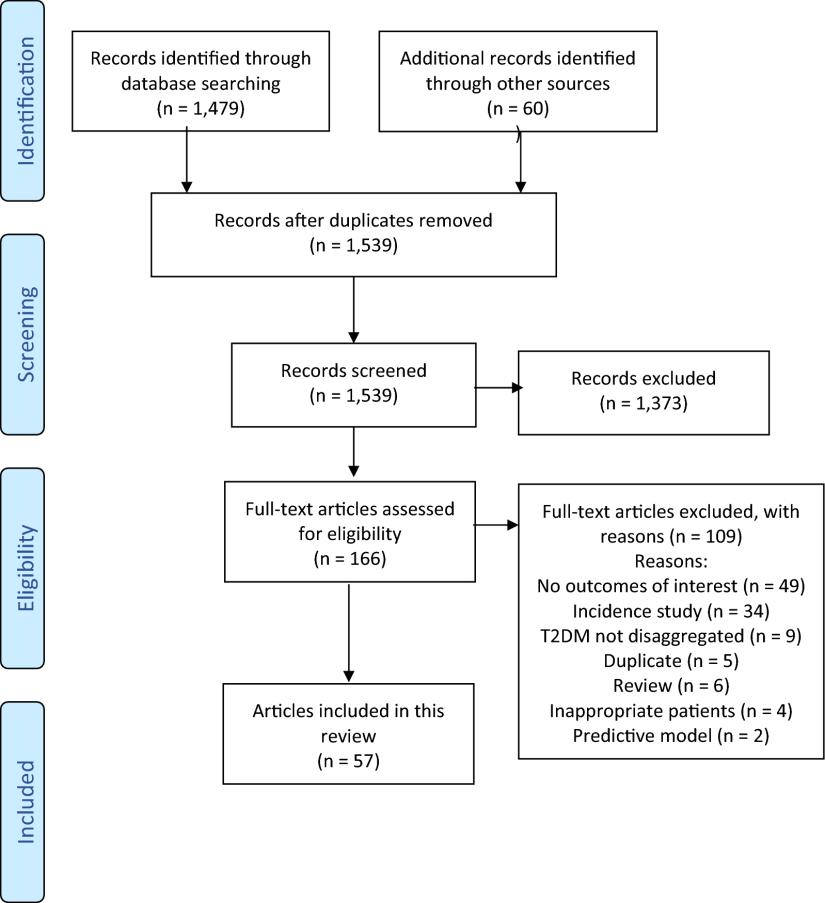
ISSN 2348-1196 (print)
International Journal of Computer Science and Information Technology Research ISSN 2348-120X (online) Vol. 9, Issue 4, pp: (65-74), Month: October - December 2021, Available at: www.researchpublish.com
Characteristics
CAD (n=510) Control (n=532) p-value
Age (Years±SD) 50.96±10.99 42.69±9.25 <0.001
Male sex (%) 87.3 68 <0.001
BMI (kg/m2±SD) 24.05±3.55 24.56±2.84 0.021 Smokers (%) 57 9.3 <0.001 HR (BPM±SD) 79.95±12.47 76.94±7.62 <0.001
SBP (mmHg±SD) 127.41±20.03 121.12±9.47 <0.001
DBP (mmHg±SD) 82.09±11.69 74.84±6.67 <0.001
#RBS (mg/dL±SD) 131.69±63.55 103.45±28.02 <0.001
#Na+ (mEq/L±SD) 135.57±5.75 139.06±2.35 <0.001
#K+ (mEq/L±SD) 3.86±1.95 4.12±1.83 0.053
#UREA (mg/dL±SD) 27.89±8.93 20.79±5.93 <0.001
#CREA (mg/dL±SD) 1.04±0.23 0.94±0.24 <0.001
#TC (mg/dL±SD) 174.74±39.77 174.78±33.78 0.990
#TGL (mg/dL±SD) 137.24±55.53 128.80±65.86 0.198
#HDL (mg/dL±SD) 38.96±6.10 38.16±12.41 0.578
#LDL (mg/dL±SD) 130.83±32.30 105.35±27.97 0.002
Table2 : Characteristics of CAD
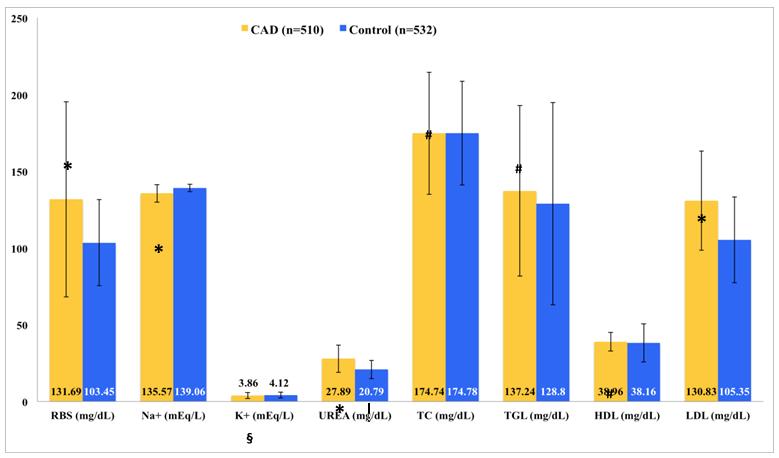
Genomic DNA from the CAD patient’s blood samples were isolated by Phenol:Chloroform:Isoamyl alcohol extraction procedure and the DNA were dissolved in 1X TE buffer. DNA samples were resolved in 0.7% agarose gel and a representative gel picture was shown in Fig
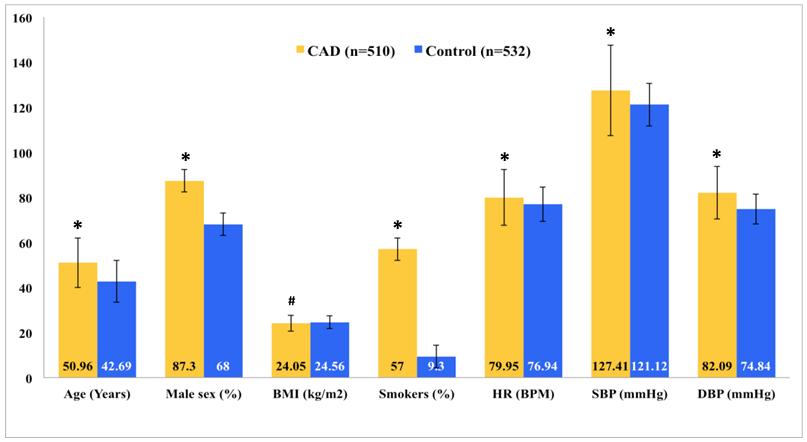
ISSN 2348-1196 (print)
International Journal of Computer Science and Information Technology Research ISSN 2348-120X (online) Vol. 9, Issue 4, pp: (65-74), Month: October - December 2021, Available at: www.researchpublish.com
locus SNPs rs10757274, rs10757278 and rs10965244 were screened in the South Indian CAD and controls to find their association with CAD risk. All the three SNPs of 9p21.3 locus were in Hardy Weinberg Equilibrium (HWE), Pearson's Chi-squared test with simulated p-value (based on 10000 replicates) estimating HWEp >0.05 The GG risk genotypes of SNPs rs10757274 and rs10757278 were significantly associated with CAD, with odds ratio (OR) 1.606 & 1.520 and pvalue 0.00898 & 0.002 respectively. The TT risk genotype of rs10965244 showed no association with CAD, with an OR 1.39 and p-value 0.5983
India has the world’s most diverse population of more than 1.2 billion people comprising ~4,700 communities speaking 325 languages. The entire Indian population is extremely distinct in terms of culture, biological, social characteristics, language and religion (Umamaheswaran et al., 2014). A clear evidence of increased CAD and MI risk observed by various research reports highlights the importance of understanding the risk towards the development of the disease in a population specific manner. Especially in developing countries like India, the urbanization and industrialization mediated growth increased the risk to develop CAD at the early age. Comprehensive studies till date have identified several traditional and modifiable risk factors (e.g., Dyslipidemia, Hypertension, Smoking) and recent genomic studies mostly using CAD cases of the European, American and Asian populations found 53 chromosomal loci associated with CAD risk.
Considering Indian population as the high-risk group of developing CAD and the limited research findings available on the genetic determinants, it is important to study the genetic variants in Indian populations. The candidate SNPs in the present study were selected based on their implication over the risk of CAD established by previous findings and strong association with CAD through a conventional pathway.
5.2. Age: The present study data established unique clinical characteristics among the south Indian coronary artery disease patients. A clear evidence of early onset of age (mean±SD) 51±11 years was found in the present study of south Indian CAD/MI patients (Table 4.1a). This was similar to the south Asian study report by Joshi et al. (2007) which reported the mean age of 53±11.4 years as the onset for the occurrence of first MI. Present data showed an increased CAD risk over the age (>45 years) when compared with controls (RR=1.84; 95%CI = 1.605 to 2.109)
Sex: Clear male preponderance was established with CAD risk in the present study population, 87.3% of the CAD patients were malesThere is evidence of gender difference in the CAD pathophysiology, in women CAD normally develops 7 to 10 years later than men but CAD is still one of the major cause of death in women (Maas and Appelman, 2010). There were contradictory reports explaining the role of estrogen in the development of early CAD in male than female. Experimental observations have confirmed that females favorably influence cardiac remodeling after ischemia/reperfusion injury and proved cardiac tolerance to ischemia than males (Ostadal and Ostadal, 2014). In the present study males showed a significant risk for CAD than females with RR=2.153 (95%CI=1.755 to 2.671; pvalue<0.001) The increased CAD risk among males in the present data may be due to the smoking habit among males and protective role of sex hormone (estrogen) in female patients.
5.3. Smoking: A strong evidence of smoking as one of the important risk factor for CAD/MI was observed in the present study and 57% of CAD patients were smokers (Table 4.1a). The present south Indian case control data showed smoking as a significant risk for CAD (RR=3.052; 95% CI 2.671 to 3.488) (Table 4.1b). Our results were similar to the findings of overall cohort of INTERHEART study report on South Asian MI patients in which smoking represented RR of 2.73 (95% CI 1.90 to 3.92) (Teo et al., 2006). Similarly another report by Aggarwal et al. (2012) from New-Delhi compared young CAD patients (<40years) with age matched controls and showed smoking as one of the strongest risk for early onset, RR=17.6 (95%CI=9.2-33.4). Overall smoking is an established, independent and strong risk for CAD in an unbiased manner to all ethnic/age/sex populace
Present study findings showed strong association of two 9p21.3 SNPs; rs10757274 (A>G) and rs10757278 (A>G) with the CAD risk: OR=1.606(95%CI=1.108 to 2.33) & OR=1.520(95%CI=1.056 to 2.193) respectively with significant pvalue <0.05. Another study SNP, rs10965244 (A>T) did not associate with CAD risk; OR=1.390 (0.418 to 4.906); pvalue = 0.5983 VThe 9p21.3 SNPs rs10757274 and rs10757278 were in strong LD with D’=0.9785, but rs10965244 is not linked either with rs10757274 and rs10757278 (D’=0.4574 and 0.4382)
ISSN 2348-1196 (print)
International Journal of Computer Science and Information Technology Research ISSN 2348-120X (online) Vol. 9, Issue 4, pp: (65-74), Month: October - December 2021, Available at: www.researchpublish.com
• Strong recommendation for the poor metabolizer phenotypes (CYP2C19 status: *2/*2, *3/*3 & *2/*3) implicating that patients show notably reduced platelet inhibition and elevated residual platelet aggregation and are at the strong risk of stent thrombosis hence they should to be considered for alternative antiplatelet therapy (prasugrel or ticagrelor).
• Moderate recommendation for the intermediate metabolizer phenotypes (CYP2C19 status: *1/*2, *1/*3 and *2/*17) implicating that patients may show reduced platelet inhibition and residual platelet aggregation hence alternative antiplatelet therapy may be considered.
• Strong recommendation for the ultrarapid and extensive metabolizer phenotypes (CYP2C19 status: *1/*17, *17/*17 and *1/*1) implicating increased or normal platelet inhibition respectively and these individuals could be suggested for standard dosing of clopidogrel.
CAD is a complex disease with established conventional risk factors like smoking, high circulatory lipids, hypertension, diabetes, obesity, stress, etc. Indian population is one of the high CAD risk group but only a few research studies were available addressing the complexity and early onset of the disease. Various genome wide studies and population based replication studies identified ~53 chromosomal loci and more than 400 genetic variants associated with CAD risk. The wide inter- individual variation observed in the treatment response to statin and clopidogrel is mainly due to the pharmacogenetic variants in the drug transporter and metabolizer genes like SLCO1B1 and CYP2C19. A total of 510 clinically diagnosed CAD cases and 532 healthy controls of south Indian population were screened for a total of 8 candidate SNPs associated with CAD risk and 6 pharmacogenetic SNPs associated with treatment outcome and sideeffects of CAD drugs (Statin and Clopidogrel) in South Indian population.
[1] Adithan, C., Gerard, N., Vasu, S., Rosemary, J., Shashindran, C. H., & Krishnamoorthy, R. (2003). Allele and genotype frequency of CYP2C19 in a Tamilian population. British journal of clinical pharmacology, 56(3), 331-333.
[2] Aggarwal, A., Aggarwal, S., Goel, A., Sharma, V., & Dwivedi, S. (2012). A retrospective case- control study of modifiable risk factors and cutaneous markers in Indian patients with young coronary artery disease. JRSM cardiovascular disease, 1(3), 8.
[3] Almontashiri, N. A., Fan, M., Cheng, B. L., Chen, H. H., Roberts, R., & Stewart, A. F. (2013). Interferon-γ activates expression of p15 and p16 regardless of 9p21. 3 coronary artery disease risk genotype. Journal of the American College of Cardiology, 61(2), 143-147.
[4] Ancheta, I. B., Battie, C. A., Richard, D., Ancheta, C. V., Borja-Hart, N., Volgman, A. S., & Conley, Y. (2014). The Association between KIF6 Single Nucleotide Polymorphism rs20455 and Serum Lipids in Filipino-American Women. Nursing research and practice, 2014.
[5] Anichavezhi, D., Chakradhara Rao, U. S., Shewade, D. G., Krishnamoorthy, R., & Adithan, C. (2012). Distribution of CYP2C19* 17 allele and genotypes in an Indian population. Journal of clinical pharmacy and therapeutics, 37(3), 313-318.
[6] Arsenault, B. J., Boekholdt, S. M., Hovingh, G. K., Hyde, C. L., DeMicco, D. A., Chatterjee, A., ... & Kastelein, J. J. (2012). The 719Arg variant of KIF6 and cardiovascular outcomes in statin-treated, stable coronary patients of the treating to new targets and incremental decrease in end points through aggressive lipid-lowering prospective studies. Circulation: Cardiovascular Genetics, 5(1), 51-57.
[7] Bailey, K. M., Romaine, S. P., Jackson, B. M., Farrin, A. J., Efthymiou, M., Barth, J. H., ... & Balmforth, A. J. (2010). Hepatic metabolism and transporter gene variants enhance response to rosuvastatin in patients with acute myocardial infarction-The GEOSTAT-1 study. Circulation: Cardiovascular Genetics, 3, 276-285.
[8] Bare, L. A., Morrison, A. C., Rowland, C. M., Shiffman, D., Luke, M. M., Iakoubova, O. A., ... & Boerwinkle, E. (2007). Five common gene variants identify elevated genetic risk for coronary heart disease. Genetics in medicine, 9(10), 682-689.
ISSN 2348-1196 (print)
International Journal of Computer Science and Information Technology Research ISSN 2348-120X (online) Vol. 9, Issue 4, pp: (65-74), Month: October - December 2021, Available at: www.researchpublish.com
[9] Bare, L.A., Ruiz-Narvaez, E.A., Tong, C.H., Arellano, A.R., Rowland, C.M., Catanese, J.J., Sacks, F.M., Devlin, J.J., and Campos, H. (2010). Investigation of KIF6 Trp719Arg in a case- control study of myocardial infarction: a Costa Rican population. PloS one, 5(9), e130181.
[10] Bhanushali, A. A., Contractor, A., Shah, V. T., & Das, B. R. (2011a). Investigation of KIF6 Trp719Arg in a casecontrol study of coronary artery disease in Western Indians. Genetic testing and molecular biomarkers, 15(12), 883886.
[11] Bhanushali, A. A., Parmar, N., Contractor, A., Shah, V. T., & Das, B. R. (2011b). Variant on 9p21 is strongly associated with coronary artery disease but lacks association with myocardial infarction and disease severity in a population in Western India. Archives of medical research, 42(6), 469-474.
[12] Cavusoglu, E., Chopra, V., Gupta, A., Choksi, P. U., Ruwende, C., Yanamadala, S., ... & Marmur,J. D. (2009). Relation of baseline serum potassium levels to angiographic findings in patients with known or suspected coronary artery disease. American journal of hypertension, 22(7), 754-762.
[13] Chan, M. Y., Tan, K., Tan, H. C., Huan, P. T., Li, B., Phua, Q. H., ... & Koay, E. (2012). CYP2C19